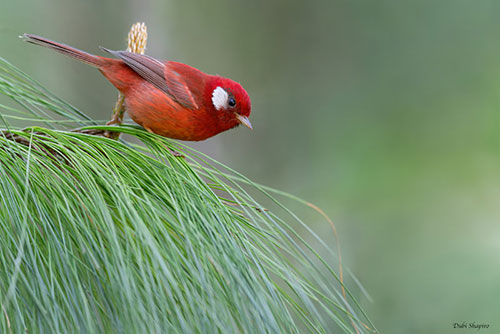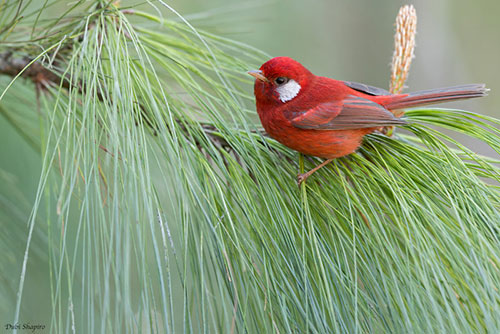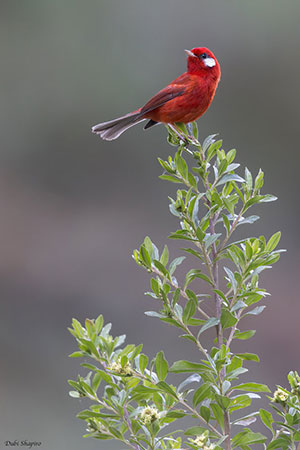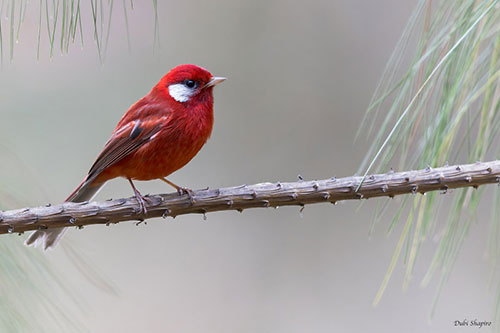
Fr: Paruline rouge
Ang: Red Warbler
All: Purpurwaldsänger
Esp: Reinita Roja
Ita: Parula rossa
Nd: Rode Zanger
Sd: röd skogssångare
Photographer:
Dubi Shapiro
Dubi Shapiro Photo Galleries
Text by Nicole Bouglouan
Sources:
HANDBOOK OF THE BIRDS OF THE WORLD Vol 15 by Josep del Hoyo-Andrew Elliot-David Christie - Lynx Edicions – ISBN: 9788496553682
A GUIDE TO THE BIRDS OF MEXICO AND NORTHERN CENTRAL AMERICA by Steve N. G. Howell, Sophie Webb - Oxford University Press - ISBN: 0198540124
New World Warblers par Jon Curson – Illustré par David Beadle, David Quinn - Editeur: Bloomsbury Publishing, 2010 – ISBN: 1408135167, 9781408135167
JSTOR - Life History of the Red Warbler
SORA - A NEST OF THE MEXICAN RED WARBLER
10,000 BIRDS - Birding, nature, conservation, and the wide, wide world
Wikipedia, the free encyclopaedia
Red Warbler
Cardellina rubra
Passeriformes Order – Parulidae Family
INTRODUCTION:
The Red Warbler is endemic to Mexico and three subspecies share the wide range.
This beautiful warbler shows uniform rose-red plumage, except on lores and ear-coverts. Male and female are similar.
This species is closely related to the Pink-headed Warbler - Cardellina versicolor of S Mexico and Guatemala.
The Red Warbler is mainly found in the highlands, and breeds in humid pine forest above 2,800 metres of elevation. It moves down to 2,000/2,400 metres in winter. It is an insect-eater and can be seen always active while foraging both in low and mid-storey. The nest built by the female is placed on the ground and protected by vegetation. They are monogamous.
The Red Warbler has a large range, and although undergoing a moderate decline, the species is not globally threatened.

DESCRIPTION OF THE BIRD:
Biometrics:
Length: 12,5 – 13,5 cm
Weight: 7,6 – 8,7 g
The Red Warbler has bright rose-red plumage overall, contrasting with the pale auricular patch which is white, silvery-white or grey, depending on the subspecies.
Both flight-feathers and rectrices are dark, mostly blackish, with rose-red edges.
The bill is flesh-coloured with dark tip (sometimes absent). The eyes are dark brown, surrounded by thin, bare eyering. Legs and feet are pale brownish.
Male and female are similar, but the female has slightly duller plumage.
The juvenile resembles adult, but it has mostly pinkish/cinnamon-brown plumage overall. Wings and tail are darker with pinkish-cinnamon edges and two paler wingbars. The auricular patch is whitish to greyish.
Bill, legs and feet are mostly yellowish-flesh, paler than in adults.
SUBSPECIES AND RANGE:
The Red Warbler has three subspecies that occur in disjunct populations. They differ mainly in colour of the ear patch and brightness of the plumage.
The subspecies are:
C.r. rubra (described above) is found in SC Mexico, from Jalisco and Michoacán to Veracruz and N Oaxaca.
C.r. rowleyi is found in S Mexico (mountains of Guerrero and S Oaxaca).
This species is very similar to nominate.
C.r. melanauris occurs in the Sierra Madre Occidental of W Mexico (Chihuahua and Durango).
This race has grey ear patch.
HABITAT:
The Red Warbler breeds in humid and semi-humid pine-oak, pine and fir forest with good understorey. Outside of breeding season and especially in winter, it frequents oak woodland at high elevation.
The species is visible from 2,000 to 3,500 metres of elevation.

CALLS AND SONGS: SOUNDS BY XENO-CANTO
The Red Warbler gives a sibilant “shee-ip” with rising terminal syllable. We can also hear a rather forceful but plaintive “pseet”.
The song includes various warbling trills at different pitches, interspersed with rich warbling notes. It is described as a series of three forceful clear notes followed by a mix of burrs, trills and chips.
BEHAVIOUR IN THE WILD:
The Red Warbler is an insect-eater. It forages at low to middle levels in the shrubs of the understorey. It searches for prey from exposed perches, while waiting several minutes for some insects to pass. Prey are gleaned from foliage by flycatching.
The Red Warbler is monogamous and both mates stay together all year round.
The courtship displays include chasing with short flights, but also extended chases through the vegetation. The displays start in mid-March. Following the chases, both mates are perched close to each other. The male sings and the female utters soft calls. The male may also sing in flight with fanned wings and tail.
Some interactions may occur between males, with one male flying into a rival’s territory. Some fights are reported.
During winter, the Red Warbler sometimes joins mixed-species flocks, but they usually forage mainly in pairs.
The Red Warbler is an altitudinal migrant. It generally breeds above 2,800 metres, but then, it moves down into the pine-oak area, down to 2,000 metres of elevation to spend the winter.
Like most Parulidae, the Red Warbler is agile in flight.


REPRODUCTION OF THIS SPECIES:
The Red Warbler breeds in mature conifer forest, along trails and watercourses with brushy edges. The nesting area is at high elevation, usually above 2,800 metres or more.
The nest is on the ground, often in dense growth. From some observations, a nest is described as a roofed structure made of woven pine needles and lined with fine grasses. A cushion-like bed of moss and lichen is below the nest, and some pieces of this vegetation are woven into the front of the structure. It is built by the female, but she is accompanied by the male during this period.
The laying takes place from March to May, and nestlings can be seen until end of June.
The female lays 3-4 whitish eggs with brown, grey and reddish speckles. She incubates alone during 15-16 days. The young fledge 10-11 days after hatching, and they are fully grown three weeks after fledging. The chicks are fed by both parents.
PROTECTION/THREATS/ STATUS:
The Red Warbler may be threatened by nest predators such as rodents, raccoons, feral cats and snakes.
The species is slowly declining, but it is currently considered to be fairly common to common. The decline is probably caused by habitat destruction, although logging may favour this species by increasing open areas.
The population is placed in the band 50,000/499,999 mature individuals.
The species is not globally threatened, and the Red Warbler is currently evaluated as Least Concern.